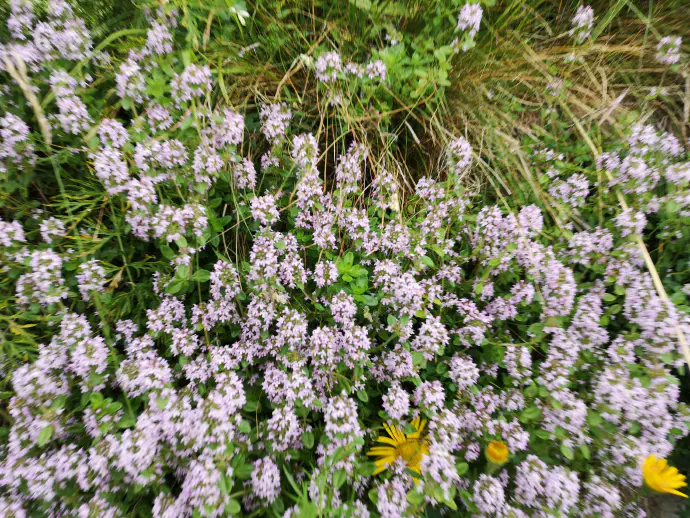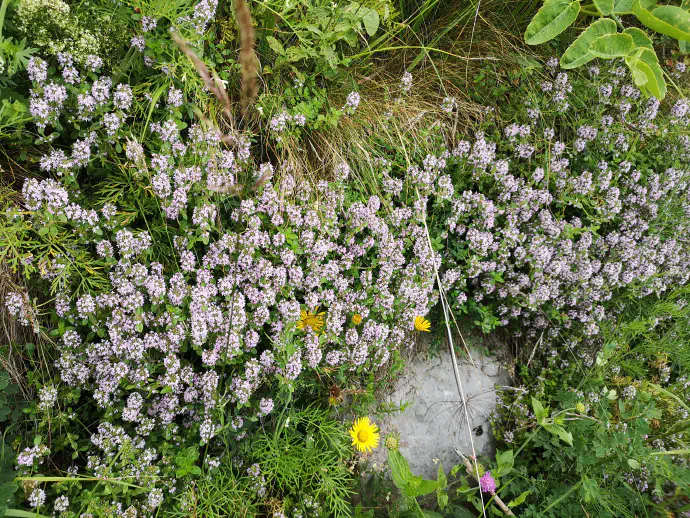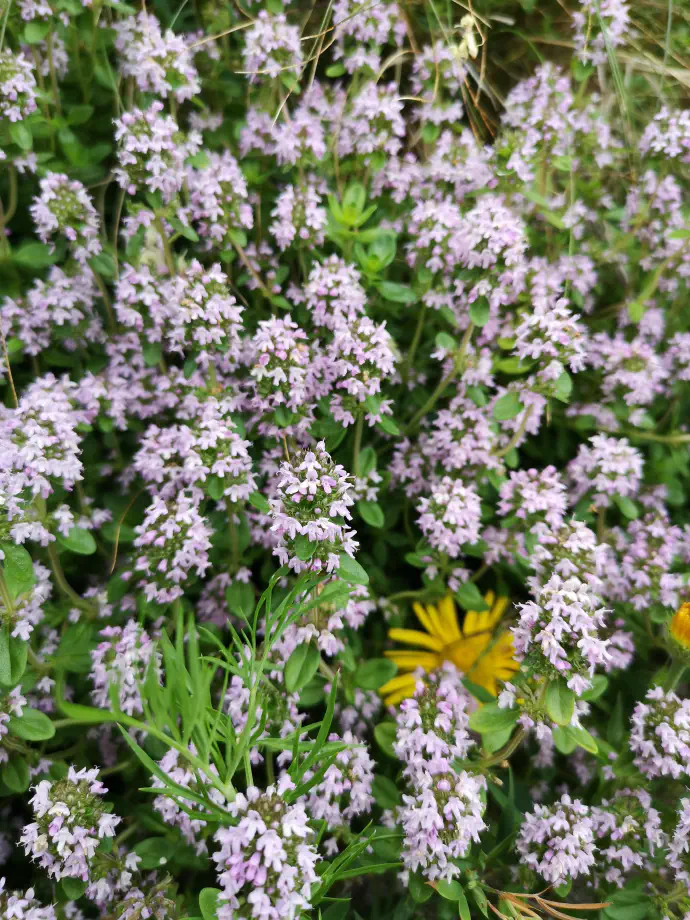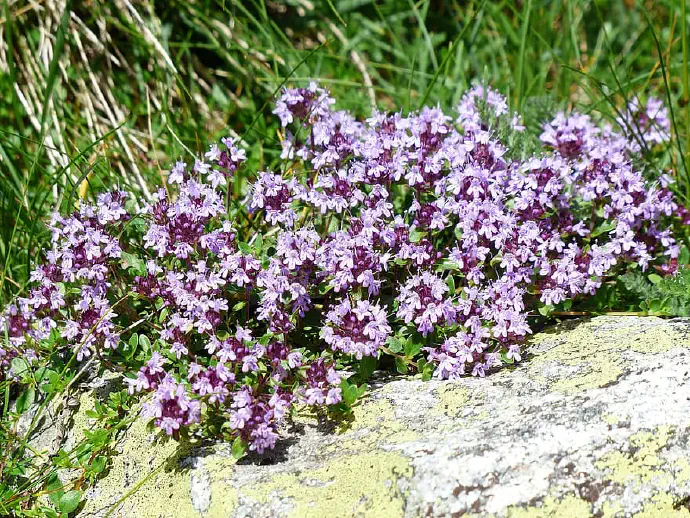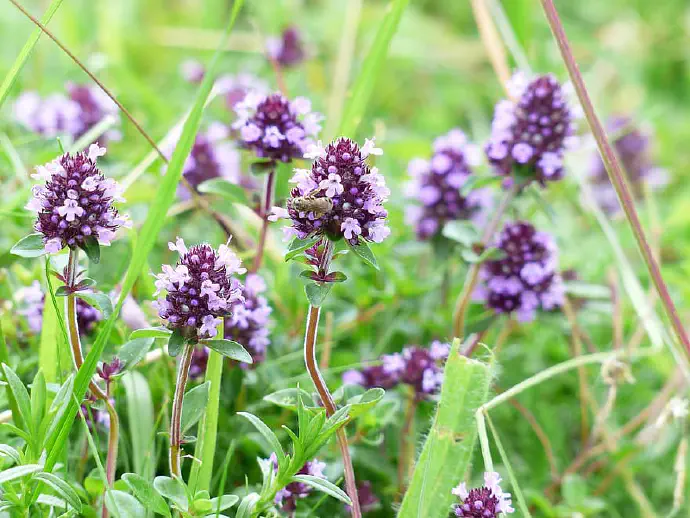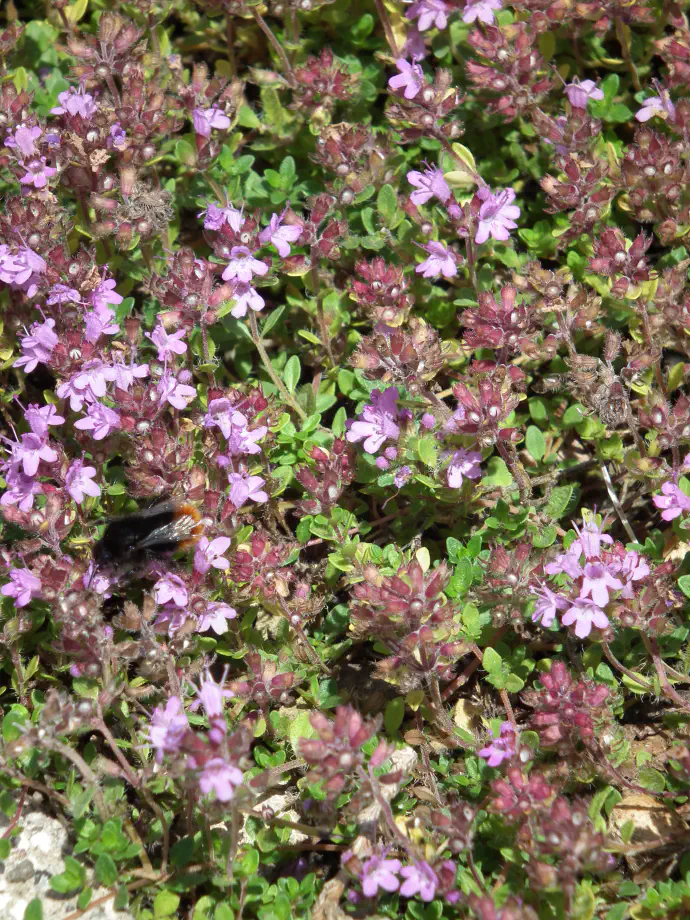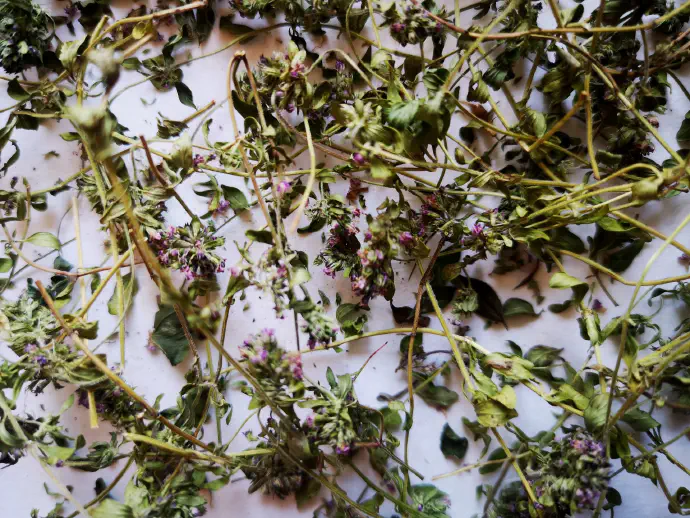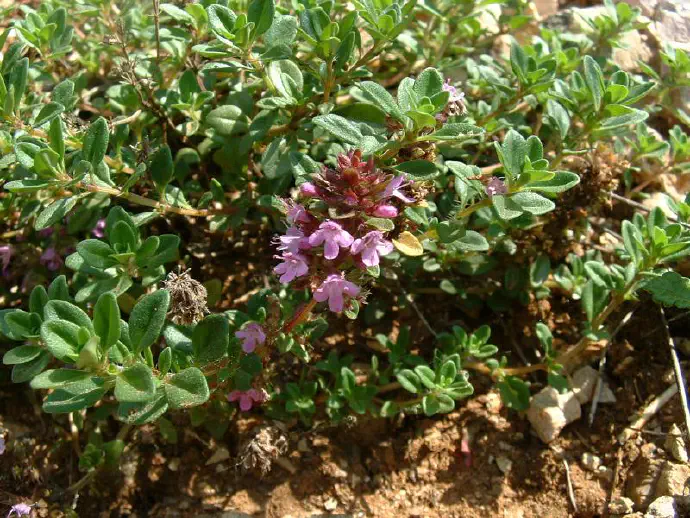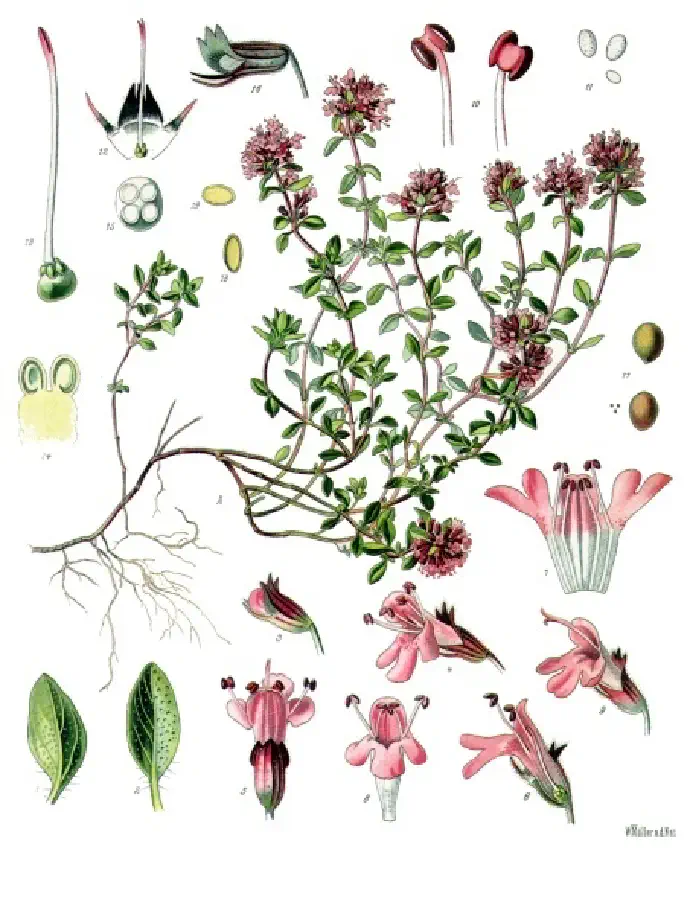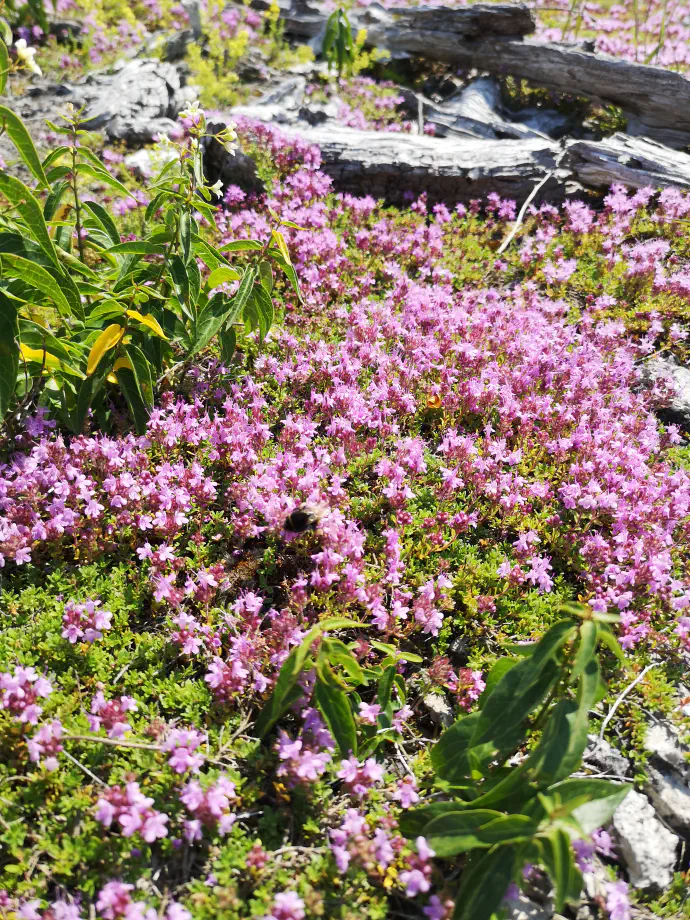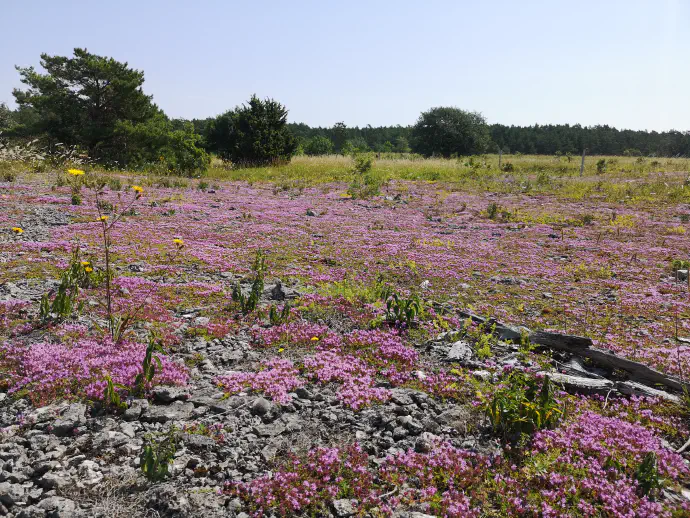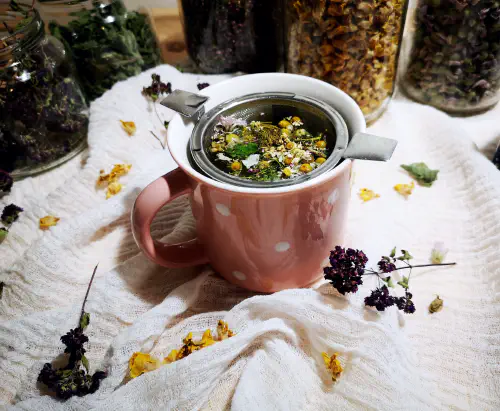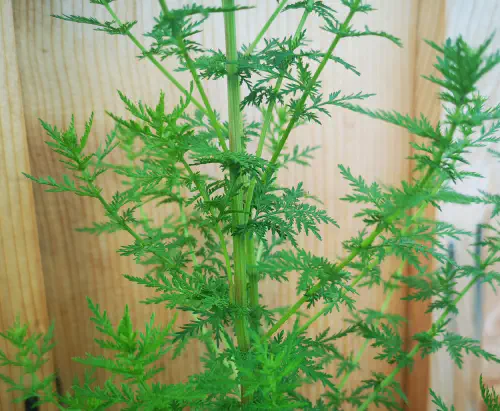About the plant
Creeping thyme (Thymus serpyllum) is a perennial herb that grows as a dwarf shrub up to 25 cm tall and can be more than half a meter wide. It has a woody rhizome from which numerous slightly hairy shoots sprout. The leaves are small and narrow, somewhat hairy and whitish below. The stems are full of slight pinkish-purple inflorescences, which are strongly scented. The scent of Thymus serpyllum is slightly reminiscent of lemon, while its taste is bitter.
It is one of the more popular herbs in folk medicine. The common blue butterfly and large blue butterfly larvae find sustenance in wild thyme, which also serves as an appealing source of nectar for bees.
Where does it grow?
Thymus serpyllum grows on sunny, dry, thin, sandy, or rocky soils. It grows along banks, roadsides, riversides, and on rocky slopes. It also grows in locations with little soil, such as between rocks.
Creeping thyme is native to south-west Asia. It came to Europe and many other countries via the Mediterranean. You can also find it in North America.
When to harvest creeping thyme?
Thymus serpyllum is harvested during the summer when the herb is flowering. It is from May to September in the northern hemisphere. Warm, dry days around midday are best for picking when the plant contains the most essential oils.
Which parts of creeping thyme to pick?
We pick the top 5–10 cm long tips of the flowering shoots of creeping thyme (Thymus serpyllum), usually during full bloom, when the concentration of essential oils is at its highest. The useful parts of the plant are the flowers and leaves, which can be dried together with the thin stems. The best time to harvest is on a sunny morning, after the dew has dried, as this helps preserve the maximum amount of aromatic compounds.
Medicinal effects
The main active ingredients of the creeping thyme are essential oils (most notably, thymol and carvacrol). Still, it also contains tannins, bitter substances, flavonoids, saponins, pentosan, vitamin B1, and chlorogenic, caffeic, ursolic, and oleanolic acids.
Because it disinfects, it can be used for washing wounds and various sports injuries. Thymol also inhibits the growth of bacteria in the respiratory, digestive, and urinary organs.
Thymus serpyllum is especially beneficial for coughs. The essential oils contained in the plant dilate the bronchi, liquefy the mucus in the airways, and accelerate coughing. It can be used for various cough types, e.g., productive and whooping cough.
It helps with colds, bronchitis, inflamed vocal cords, inflammation of the mucous membranes of the mouth, inflammation of the gums, and bad breath.
Creeping thyme improves digestion by killing parasites in the intestines and preventing the formation of intestinal winds (carminative). It also stimulates appetite.
Thymus serpyllum disinfects the urinary tract and stimulates urinary excretion (diuretic).
Creeping thyme has antispasmodic effects, so it relieves muscle spasms, including smooth muscle spasms that cause painful menstruation.
It is a sedative, which means it calms and reduces tension and irritation, so it can help us to fall asleep.
Thymus serpyllum is also attributed with anti-rheumatic effects.
How to use Thymus serpyllum?
Tea or infusion of Thymus serpyllum is drunk for colds, coughs, bronchitis, when having an inflammation of the oral mucosa, to ease menstrual cramps, to improve digestion, urine elimination, and for calming. In case of bad breath or inflammation of the oral mucosa, gums, and vocal cords, the infusion can also be gargled (in this case, double the amount of herb in the tea infusion).
The cold infusion of creeping thyme is used to rinse wounds and to make compresses for bums, sprains, and skin inflammations. Warm compresses are used for rheumatism.
Inhalations: disinfecting the respiratory tract, coughing, soothing coughs, colds, bronchitis, etc.
Essential oils are extracted from the creeping thyme using water distillation. They are used in insect repellents, perfumery, and pharmaceuticals, and they are added to creams and ointments used for muscle and joint pain.
Thymus serpyllum tincture is made by pouring 70% alcohol over the plants we collected in sunny and dry weather, leaving it to stand for at least ten days in a dark place. The preparation is then filtered and stored in a dark bottle.
The syrup of creeping thyme or thyme used for expectoration is especially suitable for children. You can prepare yourself similarly to spruce bud syrup or buy it from pharmacies. Most commercially available tyme preparations contain the related garden thyme (Thymus vulgaris).
Bath and skin care: For a relaxing, soothing bath before bedtime, pour a large amount of Thymus serpyllum infusion into the water (100 g of the herb in 1 l of boiling water). The cold infusion of Thymus serpyllum can be used for treating impure skin, pimples, and blackheads.
In the culinary arts, creeping thyme is used as a seasoning to enhance the flavor of various meat (venison, poultry, meat pies) and vegetable dishes, especially stews, legume dishes, pizzas, and sauces. It can be used both fresh and dried. It has a similar aroma to garden thyme.
Making tea or infusion
Pour 150 ml boiling water over one teaspoon of creeping thyme. Let the infusion stand for 10 minutes, then strain.
You can consume three to four cups of freshly prepared creeping thyme teas daily.
What I need to pay attention to
Children over one year of age can consume small amounts of the tea, which is prepared in the same way as for adults. Prepare a milder tea (half as much creeping thyme for the same amount of water) for babies and children under one year of age. Consult a doctor before giving creeping thyme to children.
As there is no information on the safety of using Thymus serpyllum during pregnancy and breastfeeding, it is not recommended to take it without consulting a doctor.
The essential oil of Thymus serpyllum, or more specifically, thymol, may cause an allergic reaction in some people. It can also occur with frequent use of toothpaste or mouthwashes with thymol. If it happens, refrain from using such preparations for some time.
If the plant is grown in the garden, it should be pruned once during flowering in the summertime (from mid-May to mid-September in the northern hemisphere). Refrain from cutting into the woody stems. In the first year, prune only once; in following years, limit pruning to a maximum of twice per year.
It is essential to dry the creeping thyme properly, as we want to maintain its most medicinal properties - the essential oils. It is, therefore, important that the drying temperature does not exceed 40 °C.
Several sources suggest turning the creeping thyme during drying with wooden or glass sticks and not grasping it with the hand.
Interesting facts
Thymus serpyllum is excellent for feeding bees. It can also be used in animals for problems similar to those of humans.
It is an excellent cover plant for planting in rockeries or hardening banks.
Thymus means strength and courage.
The Ancient Egyptians already used it for embalming and washing the dead.
The garden thyme, Thymus vulgaris L., is said to be even more effective against coughs than Thymus serpyllum.
Distillation of creeping thyme produces an essential oil that is red and has a slightly spicy smell.
